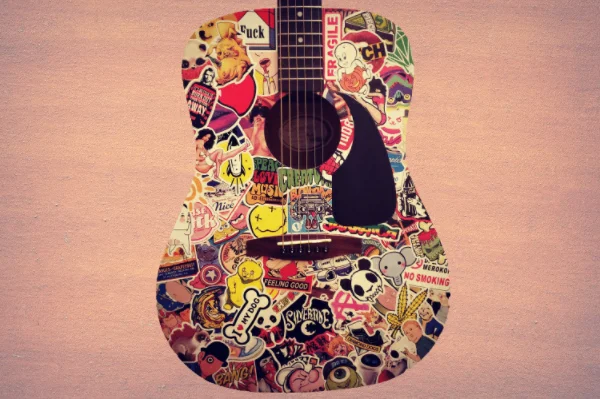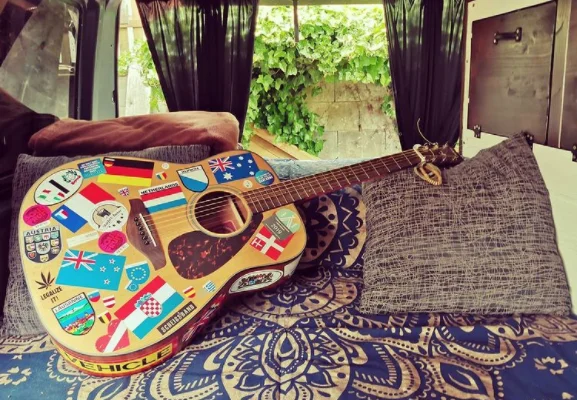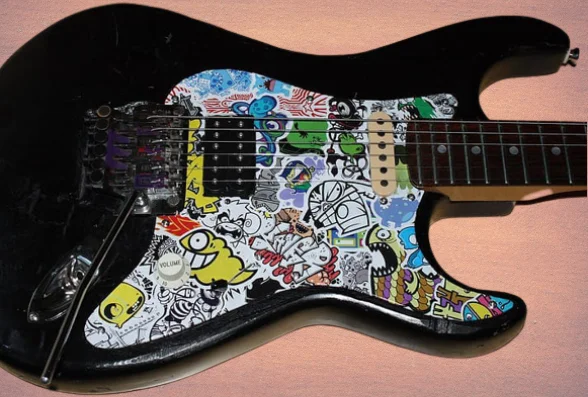Guitarists as skilled and nuanced as Steve Vai, Kurt Cobain, and Duff McKagan own guitars adorned with stickers and/or decals. Also, folk guitarists have long been spiffing up their acoustics with decals of flowers, peace signs, and well-meaning political slogans.
The urge to add a bit of personality to your guitar, especially if it’s an inexpensive one, can be great. I speak as the owner of a Fender Squire Telecaster sporting two carefully-chosen decals, so I can attest to the temptation.
But is it advisable to put stickers on guitar? Will it affect the sound of the instrument if you apply just one sticker? Can guitar stickers be removed safely? How can you remove a sticker without damaging your guitar’s finish?
In the following article, we’ll discuss everything you should know about guitars and stickers (or decals.)
Can You Put Stickers On A Guitar?
Yes, you can definitely put stickers on acoustic or electric guitars and even on your bass guitar. You can put a sticker on just about any smooth instrument surface unless it’s wet. And one need not look very far to find a picture of a guitar embellished with stickers or decals.
Whether it’s advisable to put stickers on your guitar, though, depends on several factors we’ll discuss later at length.
Does Putting Stickers On A Guitar Affect Its Sound?
Unless you unwisely cover electric guitar pickups, placing stickers on electric guitar bodies or necks won’t affect the sound at all.
On an electric guitar, the strings’ vibration is captured by magnetic pickups, so the instrument’s body barely plays a role in producing sound. That is why an unplugged electric guitar is significantly lower in volume than is an acoustic guitar.

Placing stickers on acoustic or classical guitar bodies will, in fact, alter the sound, but not enough for the human ear to detect.
According to Fender Acoustic Product Specialist Rodrigo Ibieta, anything that diminishes body vibration can affect tone. Still, one would have to purposely paper their acoustic guitar in layers of stickers to hear a discernible change.
Related Post: Will Painting An Acoustic Guitar Affect The Sound?
Can You Put Stickers On Pickups And Fretboards?
We’ve all seen high-end or custom guitars with decorated fretboards. The renowned horror author and amateur guitarist Stephen King own a beautiful acoustic guitar with bats marking the fretboard, one I personally covet.
Before you go ordering packages of the small skull or flame stickers to spruce up your maple or rosewood, keep a few things in mind.
First, remember that guitars with decorated fretboards use professional guitar decals that, once coated lightly with a clear finish, actually absorb into the wood like a tattoo. This isn’t the case with regular guitar stickers, which might impede your movement as you slide up and down the neck.
And speaking of tattoos, this brings us to a good general rule when it comes to stickers and guitars: when you decide to decorate your guitar with a sticker, plan to do so a week from the day you make your decision.
This way, you have plenty of time to be sure you really need that Randy Rhoades sticker on your flying v.
Should You Use Stickers On Your Guitar?

We opened this article by asking, “can you put stickers on your guitar?” Now, for the more pertinent question: should you put stickers on your guitar?
Of course, the answer to this question is as personal as asking, “should I get a tattoo?” I can no more answer the former for you than the latter. There are pros and cons to putting stickers on guitars, though, and you should be aware of them before taking the plunge.
Stickers can be an inexpensive, effective way of lending your guitar a bit of personality and individuality. They are easy to affix and can even be sealed so as not to degrade over time. A well-chosen, eye-catching sticker or decal can have almost as much effect as professional graphics without the associated costs.
Of course, there are cons to putting stickers on your guitar, the most significant being they can be challenging to remove. Should the time ever come that you decide you prefer your guitar sticker-free, you’ll see for yourself how much harder they are to get off than put on.
Another reason to think twice before putting stickers on your guitar is the potential damage you can do to the instrument’s finish. Aside from the damage that can occur during the removal process, adhesives used on some stickers can actually degrade your guitar’s finish over time.
Finally, keep the instrument’s resale value in mind before personalizing your guitar with stickers. I would never suggest adding stickers to a guitar over five hundred dollars.
Unless you’re currently selling out arenas, odds are you’re significantly reducing your guitar’s resale value by adding stickers. If you ever decide to sell, you’ll likely have to remove the sticker, risking damage to the guitar’s finish.
If you haven’t decided to use stickers on your guitar, get some inspiration from this video:
Where Is The Best Place To Put Guitar Stickers?
While the answer to this question is essentially a matter of personal taste, some places are likely to cause less damage than others.
When putting stickers on electric guitar bodies, consider placing them on the pick-guard rather than on the instrument’s body. Should the pick-guard get scratched or otherwise damaged when you remove the sticker, it’s a relatively easy and inexpensive part of the guitar to replace and many times less expensive than a new body.

The pick-guard on an acoustic guitar is generally smaller and offers less space for decals and adornments. Still, given the damage removal can do to a guitar’s finish, I’d still recommend this as the best place on your acoustic guitar to put a sticker.
If you’re dead-set on putting a sticker or decal on the body of your acoustic guitar, hey, go nuts. As stated earlier, it won’t affect the sound, even when amplified. You can put stickers on acoustic guitar bodies anywhere you like; the front, sides, soundboard; just remember what takes seconds to do may take days to undo.
If you want to put some stickers on your guitar, check out these trendy options:
How To Seal Guitar Decals And Stickers
To keep air from getting beneath a sticker and potentially reacting, over time, with the adhesive, you can seal stickers onto your guitar using a clear sealing tape.
As mentioned earlier, more professional-looking water-slide decals are often used to transfer brand names or graphics onto a guitar’s body or headstock. These stickers transfer onto the guitar rather than just sticking to it, creating a more permanent marking. Clear coats should be applied to seal the marking when using such decals.
How To Remove A Sticker From A Guitar
In its own way, every guitar is a thing of beauty in both form and function. That said, there’s a world of difference between a two hundred dollar starter guitar and a beauty off of the tables of the Fender Custom Shop.
I’m sure I don’t need to tell you to think very, very carefully before putting decals or stickers of any kind on a that already amounts to a work of art.

But let’s say you find a great deal on a vintage guitar, but it’s a guitar covered in stickers. Don’t pass on what could be a great guitar just yet.
Whether it’s an inexpensive model or a classic worth thousands of dollars, follow these steps to achieve the best results when removing stickers:
Consult The Professionals
The surest way to get good results when removing stickers from guitar bodies is to leave it to the pros. While removing adhesive from a guitar might seem a simple enough matter (and indeed, some websites make it seem so), it is actually a time-consuming process that requires knowledge of guitar finishes and different adhesives.
Your guitar’s finish, how long a sticker has been affixed, and the type of adhesive used on the sticker or decal can all affect the outcome of the removal process.
For this reason, it’s best to let your local guitar tech remove stickers from higher-end guitars. Most techs have experience removing stickers and decals from different guitar finishes and have the patience to follow through on what can be a time-consuming and tedious task.
Use Extreme Care
Should you decide to try removing guitar stickers yourself, be aware you’re likely to experience some damage to the guitar’s finish. As Fender Product Specialist Steve Pepper warns, even water can damage a guitar’s finish.
Using the wrong solvent can do irreparable damage to your beloved guitar. For example, using a petroleum-based solvent on a polyester-finished guitar (as are many Fenders) will cause more harm than good.
If you’re careful, though, and patiently test any remover before attempting removal, you can minimize any damage, up to the point of being practically invisible to the naked eye.
Removal
Removing paper stickers is considerably easier than removing plastic or vinyl ones, as you won’t need to lift the sticker to get at the adhesive.
Simply apply the remover (once you’ve tested it on a safe area, of course) in circular motions using a cloth. The remover will penetrate the paper to the adhesive, which will eventually clump and crumble off the guitar.
Plastic and vinyl stickers present a more significant challenge, as you’ll need to lift the sticker to access the adhesive.
You need to carefully peel up one side with the corner of the sticker with your fingernail. For lifting away the sticker, none to least amount of damage will be done if you impose moisture on the adhesive by using a slightly damp towel.
Once the plastic layer is removed (hopefully with little to no damage to the surrounding surface), you’ll be left with a sticker-shaped patch of adhesive. Then use a damp cloth with your preferred and tested solvent, then rub lightly using circular motions on the adhesive.
The process can take some time, and the temptation to rub a bit harder can be significant. Resist this urge, though, as any but the lightest of touches increases the chances of damaging your guitar’s finish.
Commercial Versus Organic Solvents
When deciding on the best type of solvent to use that matches the type of finish your guitar has, it doesn’t hurt to do a little research.
If you’re interested in a greener solvent that’s free of harmful chemicals, try a two-to-one solution of baking soda to coconut oil. Add a few drops of sweet orange essential oil for better degreasing and a fresher scent.
Adhesive Removers To Try
There are several good solvents available online, and we’ll touch on them in this section.
Goo Gone Original Liquid Sticker Lifter
Among the highest-rated and most popular adhesive removers is Goo Gone Original Liquid Adhesive Remover.
Inexpensive and works on most surfaces, Goo Gone is effective on stickers but might be a bit strong, depending on your guitar’s finish. As with any solvent, be sure to test an inconspicuous area on your guitar before using it.
Uni Solve Adhesive Remover Wipes
Also available and highly rated on Amazon, Smith and Nephew Uni Solve Adhesive Remover Wipes are another option to try.
Effective and inexpensive, Uni Solve Wipes may be the answer to your sticker-removal problems. Again, it can’t be stressed enough that any and every solvent you decide to try should first be tested.
Final Words
Putting stickers on a guitar is an easy and inexpensive way to personalize your instrument. Remember, though, that while putting one or more stickers on guitar bodies can look good, it takes a lot of work and patience to remove them without damaging your guitar.





